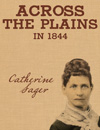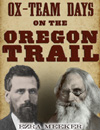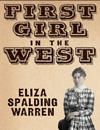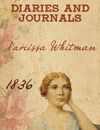Hardships
Walking 2,000 miles barefoot
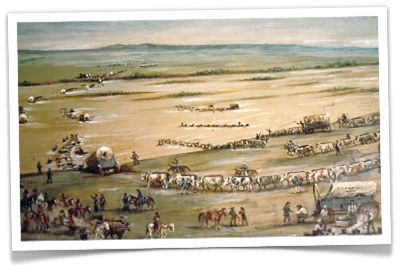
Above: Crossing the Platte River. Drownings here were common.
RIVER CROSSINGS
River crossings were a constant source of distress for the pioneers. Hundreds drowned trying to cross the Kansas, North Platte and Columbia Rivers--among others. In 1850 alone, 37 people drowned trying to cross one particularly difficult river--the Green.
Emigrant John B. Hill:
"The ferryman allowed too many passengers to get in the boat, and the water came within two inches of the gunwale. He ordered every man to stand steady as the boat was liable to swamp. When we were nearly across the edge of the boat dipped; I thought the boat would be swamped instantly and drowned the last one of us."
Those who didn't drown were usually fleeced. The charge ranged up to 16 dollars; almost the price of an oxen. One ferry earned $65,000 in just one summer. The emigrants complained bitterly.
WALKING
Because most emigrants grossly overloaded their wagons, few could ride inside. Instead most walked--many made the entire 2,000 mile journey on foot.
ACCIDENTS
The emigrant wagons didn't have any safety features. If someone fell under the massive wagon wheels, death was instant. Many lost their lives this way. Most often, the victims were children.
Edward Lenox:
"A little boy fell over the front end of the wagon during our journey. In his case, the great wheels rolled over the child's head----crushing it to pieces."
WEATHER
Great thunderstorms took their toll. A half-dozen emigrants were killed by lightning strikes; many others were injured by hail the size of apples. Pounding rains were especially difficult for the emigrants because there was no shelter on the open plains and the covered wagons eventually leaked.
CHOLERA
Perhaps the biggest problem on the Trail was a mysterious and deadly disease--called cholera for which there was no cure. Often, an emigrant would go from healthy to dead in just a few hours. Sometimes they received a proper burial, but often, the sick would be abandoned, in their beds, on the side of the trail. They would die alone. Making matters worse were animals that regularly dug up the dead and scattered the trail with human bones and body parts.
Emigrant Agnes Stewart:
"We camped at a place where a woman had been buried and the wolves dug her up. Her hair was there with a comb still in it. She had been buried too shallow. It seems a dreadful fate, but what is the difference? One cannot feel after the spirit is flown."
Cholera killed more emigrants than anything else. In a bad year, some wagon trains lost two-thirds of their people.
Emigrant John Clark:
"One woman and two men lay dead on the grass and some more ready to die. Women and children crying, some hunting medicine and none to be found. With heartfelt sorrow, we looked around for some time until I felt unwell myself. Got up and moved forward one mile, so as to be out of hearing of crying and suffering."

